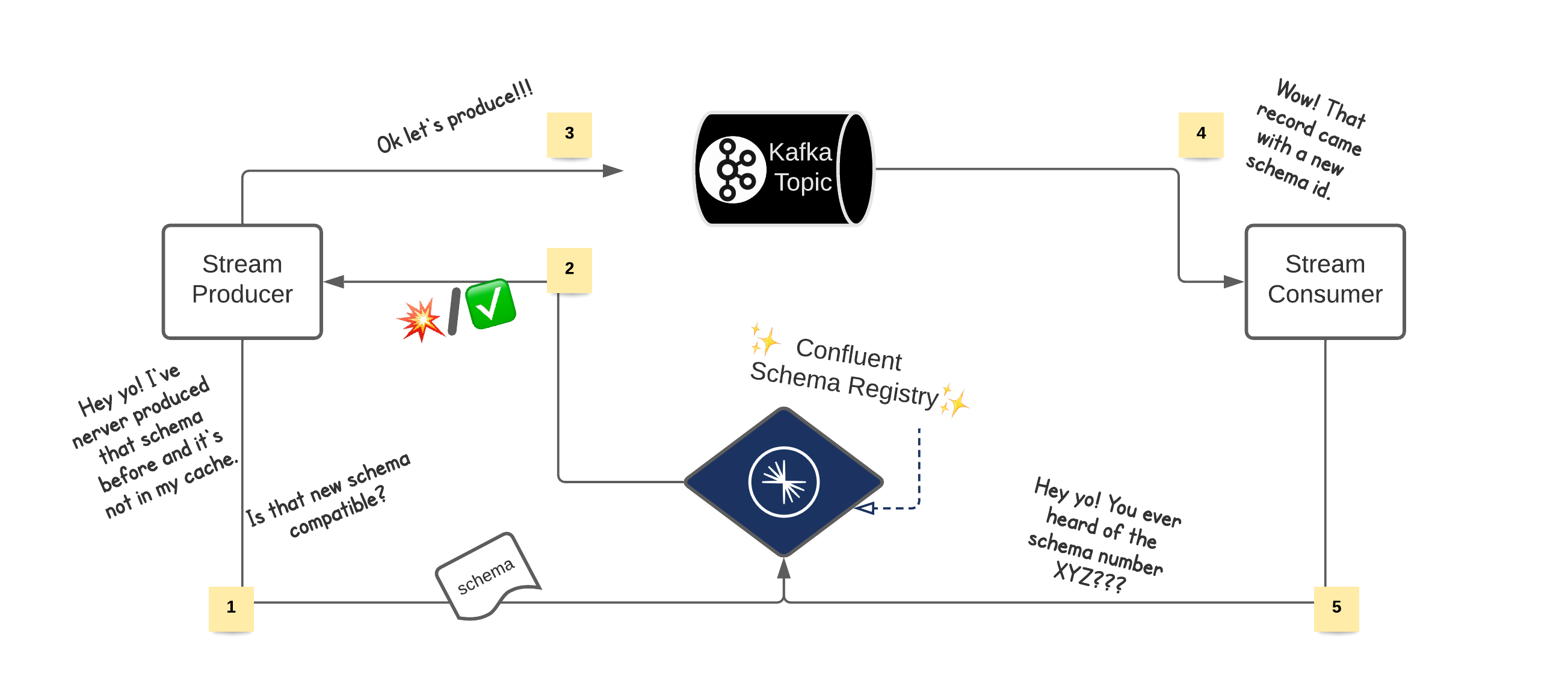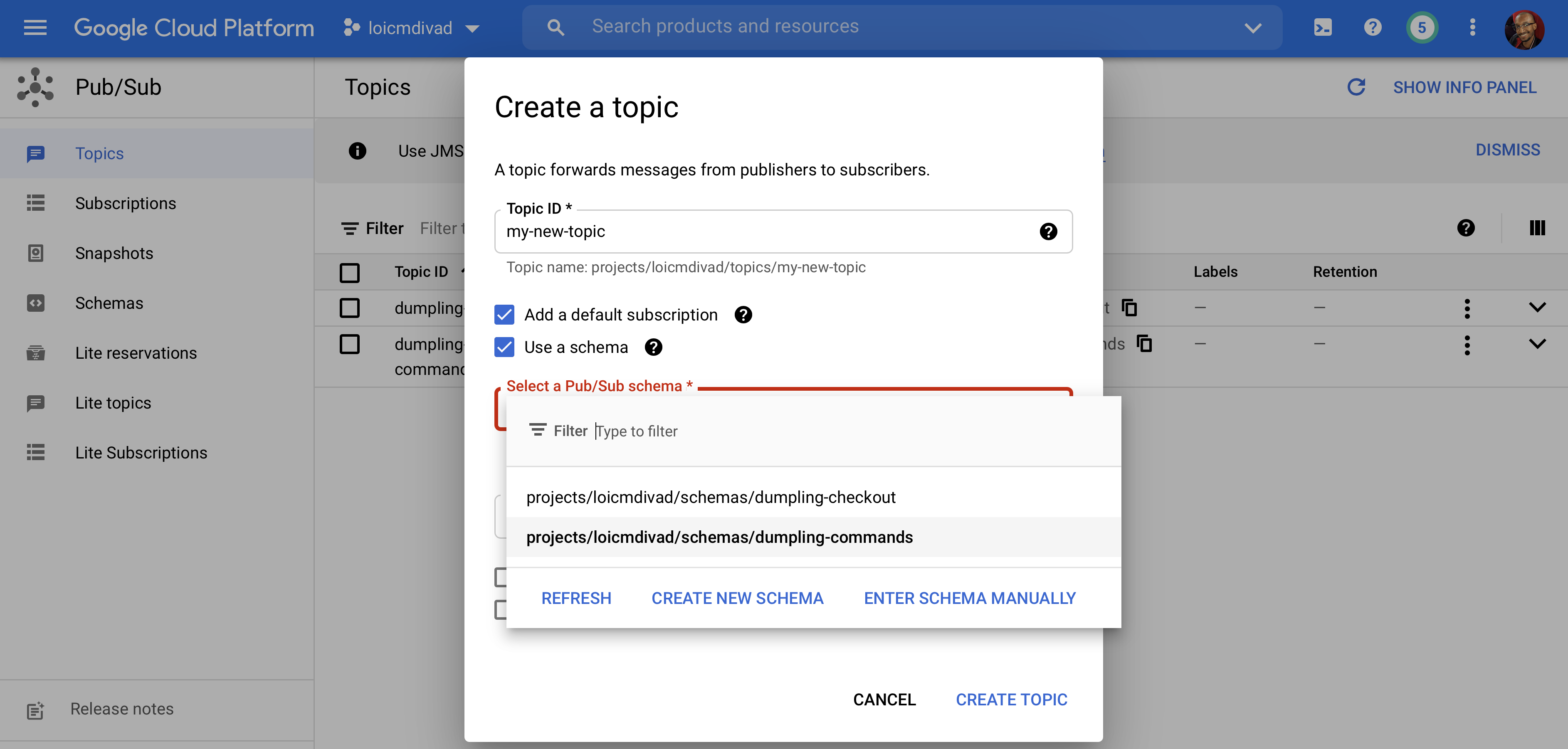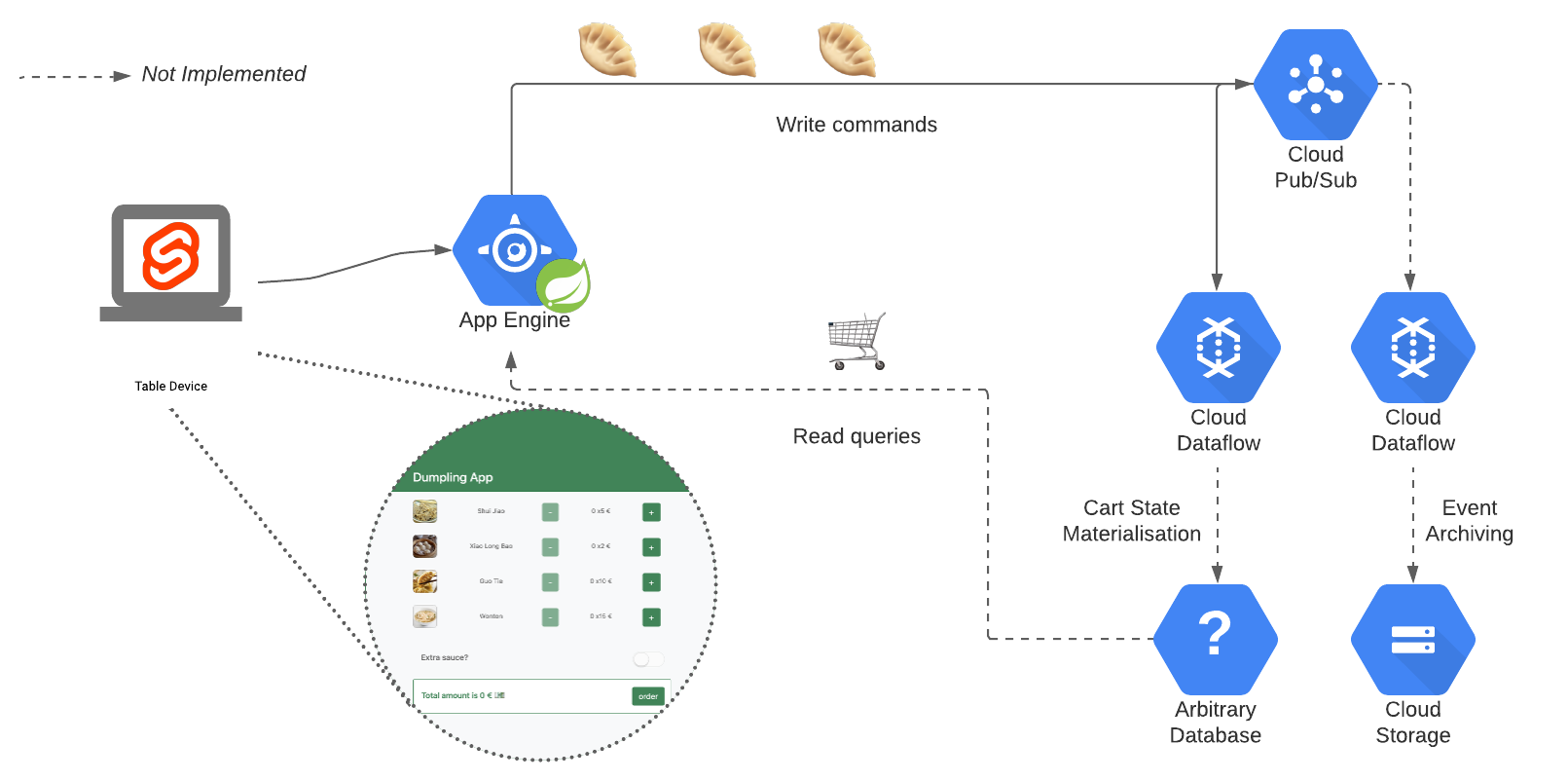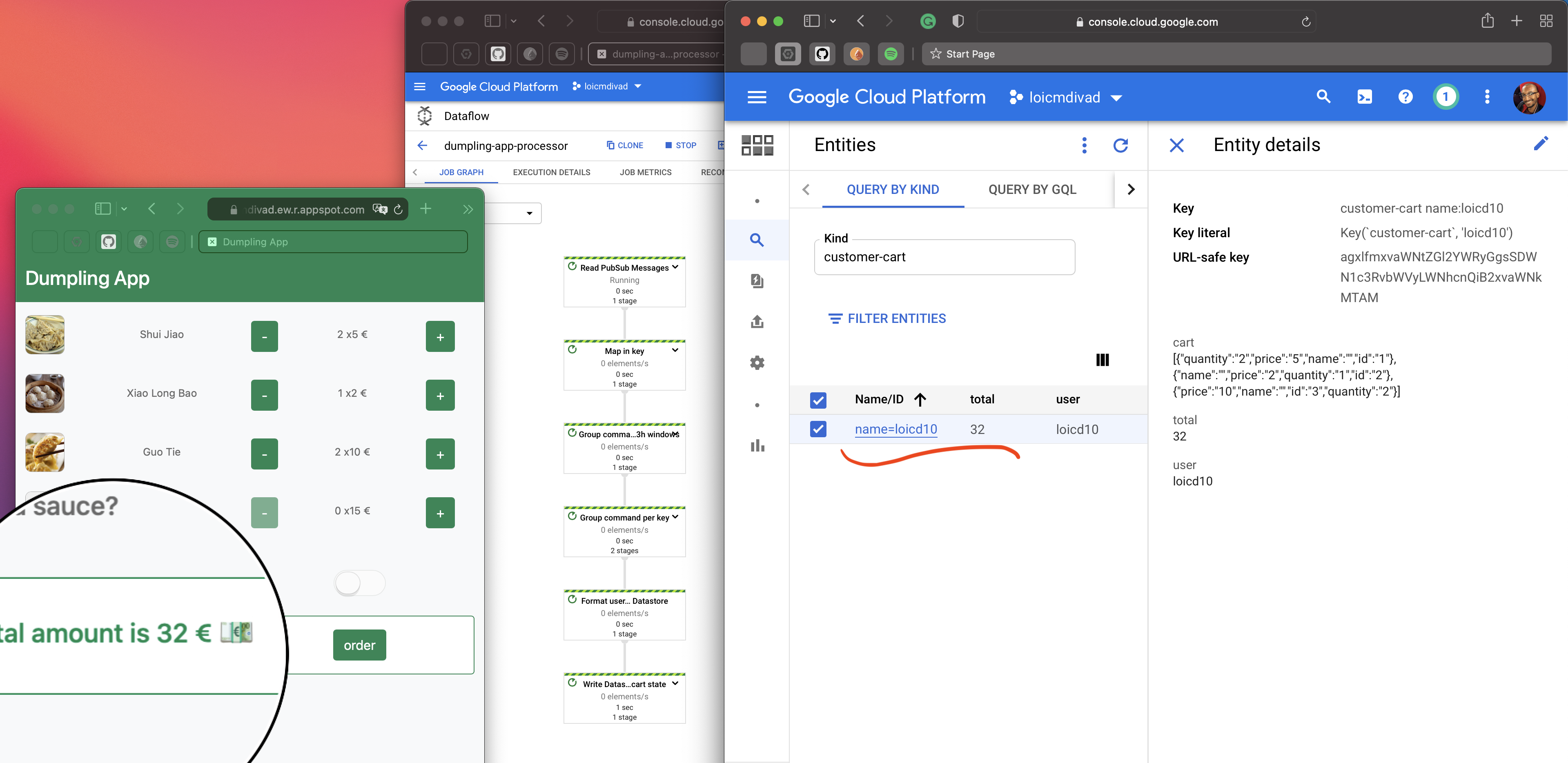This article aims to discuss data contracts in the context of event processing applications. We will follow a short example: The Dumpling App! The post also looks at that concept through specific technologies. Pub/Sub message schemas is a relatively recent feature, so let’s take it for a spin in that article.
- Motivation
- Pub/Sub Message Schemas
- Use case example: The Dumpling App
- Schema Enforcement
- Message Consumption
- Conclusion
Motivation
Event oriented architectures are powerful. They provide advanced audit capability, replayability and flexibility. But to enjoy all those features, the different applications have to interact safely with each other. Similarly to how a team would create API specifications (with a WSDL when using SOAP), there is a need to declare the shape of events flowing in a stream. The name and the type of the different fields usually completely describe the structure of the events. It is commonly called event schema. This post will refer to the association of schema and materialised stream of events ( i.e. topic, message queue) as a data contract.
One tool managing this type of data contract is the Confluent Schema Registry . When assigning a schema to the keys or values of a Kafka topic, the Schema Registry creates a new entry called subject. This subject is then exposed and provides consistency at a message level.
- This contract enforces the structure of future messages
- This contract informs how to read existing messages

The Confluent Schema Registry has been around for a while, and readers might be more familiar with it. On the opposite, organising a project around this recent Pub/Sub feature might be less obvious. This highlights the practices and techniques one can think of when working with Message Schemas. So let’s explore data contracts with Cloud Pub/Sub!
Pub/Sub Message Schemas
GCP introduced the Message Schemas feature in March 2021 and moved it to GA in June. It lets you declare an AVRO or Protobuf schema as a cloud resource. You can then point at that resource when creating a topic. Let’s see what happens next.

Use case example: The Dumpling App
Let be the Dumpling Store, a small fictional restaurant that serves dumplings. Let’s also imagine that each table has a small device providing an interface to order food. Each time you click on add an item, the app publishes an event to add a line to your order. Once you click on order, the app sends the second type of event to prepare your order. It’s basically similar to the Self-Ordering kiosk of your favourite fast food. The dumpling-app is a preview of what this application could look like using Pub/Sub Message Schema.


Photo by Febrian Zakaria on Unsplash ;
Photo by Marta Filipczyk on UnsplashThe application is (dumpling-app-service) composed of a Svelte web app and a Spring Boot web service running in App Engine. The service produces events in a Pub/Sub topic. From here, a Dataflow job continuously processes the events.

Infrastructure
The team building and running the application might also be responsible for the cloud resources. That’s why at the root of the project, a terraform directory contains the different infrastructure manifests. Luckily for the Dumpling team, the GCP terraform provider allows the declaration of schemas.
| |
See the entire file: schemas.tf .
This would be the equivalent of the following gcloud command line:
gcloud pubsub schemas create dumpling-commands \
--type=PROTOCOL_BUFFER \
--definition=$(cat src/main/proto/command.proto)
An interesting aspect of this setup is that we define schemas only once. Both Terraform and the code
generation load the same file. Terraform does it with the file()
function (line 10)
and the code generation (with the Protobuf Maven
Plugin (line 143).
Next, the different Pub/Sub topics depend on and reference the schemas.
| |
See the entire file: topics.tf .
Now, let’s dig into the schema file itself and how the rest of the application uses it.
Schema
In our example, the team is using the Protobuf serialisation system. The structure needs to be flat.
So far, the Message Schemas feature does not support imports or complex types. The add (+) and
remove (-) buttons are associated with the Command event, which has the following shape:
message Command {
int64 event_time = 1;
string item_id = 2;
string item_name = 3;
enum Operation {
ADD = 0;
REMOVE = 1;
}
Operation operation = 4;
message Session {
string user_id = 1;
string table_id = 2;
string store_id = 3;
}
Session session = 5;
}
The message ordering key is the user_id. Every event carries an event_time set by the front-end
app and a type of Operation to specify if the item should be added or removed from the user cart.
The application set some attributes such as env, version, source. But in addition to those
attributes, the client library adds two technical attributes relate to the message schema
| Attributes | Value example |
|---|---|
googclient_schemaencoding | BINARY / JSON |
googclient_schemaname | projects/?/schemas/? |
Service and interface
The HTTP API is just a typical Spring Boot module. One special thing about it is that it does not
present any entities or model package filled with POJO. Instead, the application only uses the
Protobuf generated code as the data model. The command.proto file from the previous
paragraph gives a Command.java class. The Spring Boot module automatically converts Protobuf
to JSON to interact with the front-end.
| |
Finally, the single-page web app is a Svelte module. The Spring Boot module considers the Svelte output as a resources directory . The page is not pretty, but don’t be mean to the Dumpling team, “they” are not great at front-end development.
Every time I write Javascript, a kid loses a balloon – Loïc DIVAD
Here is a short video showing the app publishing records in the input topic. We can observe the series of events, in the console, by consuming them back via a debugging tool created for the presentation.
That concludes the chapter on the application. We have listed a few things that one could put in place to organise around the idea of event schema. Now let’s try to capture the impact of the usage of this feature on external teams or components.
Schema Enforcement
It turns out another team is working on the same app. This other team works separately on a new feature: a checkbox giving access to some additional sauce. Let’s call them the Sauce team. The problem here is that they have started to work in isolation. They have implemented the feature with a completely different schema. And yet, they try to publish messages on the same topic. It is dangerous for consumers who assume that this topic contains an order event and try to decode it. By nature, most of the applications based on events are continuous and long-running processes. They can not suffer from crashes due to an invalid type of message. Otherwise, while these applications are down, some lag will start to build up.
Here is a short video showing the application’s behaviour when clicking on the new button. When the server tries to publish the messages from the checkbox, it fails with an Exception??? And return a 500 error code. Hopefully, the team will handle that response correctly. They display a warning and toggle off the extra sauce option.
In the future, the sauce team will want to fix this problem. It turns out Cloud Pub/Sub provides an API to check a message against an existing Pus/Sub Message Schema. By giving the body of the message and a schema name, the API tells you if it is correct. It helps to comply with existing data contracts.
gcloud pubsub schemas validate-message \
--message-encoding=BINARY \
--message=$(cat ./test.json) \
--schema-name=dumpling-commands

One can perform the same verification with the user interface cloud console.
Message Consumption
Now, let’s move to another aspect of working with schema: Message consumption. Let’s imagine a third team that would build another type of application, this time, a stream processing app. Using Dataflow, they gather all user interaction events to compute their shopping cart in real-time. The dumpling-app-processor is a simplistic module representing this idea. The very first step is to consume and deserialise the input records.
| |
For this reason, we quickly realise that we need the schema we’ve introduced before in this module too. How to share it?
The service team produces that data, and at the moment, owns the corresponding schema. The processing team should definitely not copy the schema into its module. Instead, we can think of a plugin to resolve the schema dependency before running the code generation. Tools such as Protoman exist, but they mostly come with their own registry. In our example, we want to integrate the Google Cloud API as a source of thought for the schema.
pubsub-schema-maven-plugin is a quick implementation of that idea. It is a maven plugin that the processing team could use to fetch the schema.
<plugin>
<groupId>fr.ldivad.dumpling</groupId>
<artifactId>pubsub-schema-maven-plugin</artifactId>
<version>0.1.0-SNAPSHOT</version>
<configuration>
<project>${gcp.project}</project>
<schemas>
<schema>dumpling-commands</schema>
<schema>dumpling-checkout</schema>
</schemas>
</configuration>
<executions>
<execution>
<phase>generate-sources</phase>
<goals>
<goal>proto-files</goal>
</goals>
</execution>
</executions>
</plugin>
After reading the commands, the Dataflow job maps them in key-value pairs. The job groups the pairs by key over a large time window. A trigger is a setup so that quickly after a state update, the job will emit the new state of the shopping cart. Finally, this example writes in Datastore (which is just an arbitrary choice to get simple feedback for the job).
| |
See the entire file: Main.java .

This is an oversimplified example. But still, it is concrete enough to start imagining how we could build materialised views in this context. Those views would contribute to a read model similar to the one we rely on when using CQRS or other event-sourcing patterns.
Conclusion
We have seen the benefice of having a data contract in place through this demo example. The data contract protects the application against its own failure by enforcing the type of message for a topic. And it helps the other application to decode those messages. However, in the particular case of the Pub/Sub Message Schemas feature, the advantages fall short. The feature is really new (about a year at the publication of this post), and there are still a few options missing. The biggest is schema evolution. At the moment, topics can not have new schemas. And if a used schema is deleted, the publications for that topic will simply fail. But when thinking about it , it makes sense for the early beginning of this feature. Because adopting schema is not easy. And establishing compatibility levels is also quite tricky. Having a zero compatibility level policy is a way to put a lower entry barrier on schema management. Similarly, the support for Pub/Sub Lite, the support for complex types or imports in Protobufs schema, feel like options that should be present but are missing at the moment. That is why we might see many exciting things coming into that product in the future.